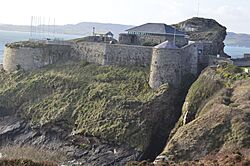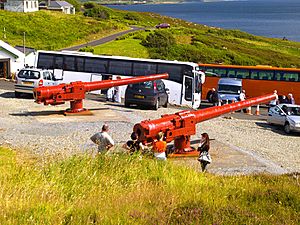Fort Dunree facts for kids
Quick facts for kids Fort Dunree |
|
|---|---|
| Inishowen peninsula Ireland |
|

Dunree Fort, 2015
|
|
| Coordinates | 55°11′48″N 7°33′11″W / 55.196739°N 7.553042°W |
| Site information | |
| Open to the public |
Yes |
| Condition | Complete |
| Site history | |
| Built | 1812-13 (c) |
| In use | Museum |
| Materials | Stone |
Fort Dunree is an old fort built to protect the coast. It's located on the Inishowen peninsula in County Donegal, Ireland. Its name in Irish, An Dún Riabhach, means "Grey Fort," or Dún Fhraoigh means "Fort of Heather."
Contents
History of Fort Dunree

Fort Dunree sits on a rocky piece of land that sticks out into the sea. You can reach it by crossing a natural crack in the rocks. It was first built around 1812-1813. This fort was part of a group of forts made to protect Lough Swilly. This was important during the Napoleonic Wars, a time when France and other European countries were often at war. Fort Dunree was built across the water from another fort called Knockalla Fort.
After the wars ended in 1815, the fort was not used much. But in 1874, it was given seven large 24-pounder guns.
Fort Upgrades and World War I
The fort was updated again in 1895. It received two 4.7-inch (120 mm) quick-firing guns at a lower level. Later, it also got 12-pounder (5 kg) quick-firing guns and two 6-inch (152 mm) guns in an upper area. The top of a nearby hill was also walled off to create a strong defensive area. Both of the 6-inch guns were used during World War I, which lasted from 1914 to 1918.
Fort Dunree as a Treaty Port
What Were Treaty Ports?
On December 6, 1921, an agreement called the Anglo-Irish Treaty was signed. This treaty led to the creation of the Irish Free State on December 6, 1922. The treaty also said that the British would keep control of three important ports. These were known as the Treaty Ports. One of these ports was Lough Swilly, where Fort Dunree is located.
The treaty stated that the "Harbour defences to remain in charge of British care and maintenance parties." This meant that even after Ireland became independent, the Royal Navy (the British navy) continued to have a presence at Fort Dunree.
Handover to Ireland
Fort Dunree remained under British control until October 3, 1938. This change happened because of another agreement, the Anglo-Irish Trade Agreement, signed on April 25, 1938. Under this agreement, the land was given back to Ireland.
On October 4, 1938, a newspaper called The Times reported on the handover of Lough Swilly at Fort Dunree. The article said that Britain's last forts in Ireland, those at Dunree and Leenan, were given to the Irish Defence Forces. The ceremony at Dunree was small, with only a few people watching.
The British flag, called the Union Jack, was lowered by two British soldiers. Then, the Irish flag, which is green, white, and orange, was raised by two Irish soldiers. The ceremony was moved to an earlier date because of the international situation at the time. When the British troops left, they were given a friendly farewell. It was a special moment because the British soldier who lowered the Union Jack and the Irish soldier who raised the Irish flag were brothers-in-law. This event marked the end of a long time of British military presence in Ireland. It was also the last time any land was given back to Ireland.
The guns at Fort Dunree were operated by the Irish Army until they were taken out of service after World War II. Fort Dunree was then used by the Irish Army for training until 1990.
Fort Dunree Today: A Museum
Today, Fort Dunree is a military museum. It has many interesting exhibits that show its history. You can see restored guns, like the BL 6 inch Mk VII naval gun, and explore an old military camp. The museum also has displays about the local birds, sea creatures, and plants found along the coast.
Other things you can find at Fort Dunree include a gift shop, a place for presentations, and a café. There are also walking trails where you can enjoy the beautiful scenery.


